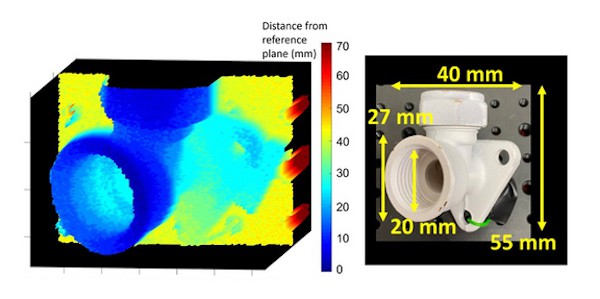A new LIDAR system can image objects in three dimensions underwater using a single-photon detector array. Developed by researchers at Herriot-Watt University in the UK, the technology could come in handy for applications such as inspecting, monitoring and surveying underwater objects, off-shore engineering, and even archaeology.
“To the best of our knowledge, this is the first prototype of a fully-submerged imaging system based on quantum detection technologies,” says team leader Aurora Maccarone. While the team had previously demonstrated imaging using single-photon detection techniques that could penetrate turbid or highly attenuating underwater environments, the latest work goes a step further, proving that the system can indeed function while fully submerged in a large test tank. The researchers also improved the hardware and software used to reconstruct the 3D images, enabling them to perform the imaging in real time.
3D imaging in highly turbid waters
The operational concept of the sensor is quite simple, Maccarone explains. First, a green pulsed laser source illuminates the scene of interest. Objects in the scene reflect this pulsed illumination, and an ultra-sensitive array of single-photon detectors picks up the reflected light. “By measuring the return time of the reflected light, the distance to the target can be accurately measured, which allows us to build the 3D profile of the target,” says Maccarone. “Typically, the timing measurement is performed with picosecond timing resolution, which means we can resolve millimetre-scale details of the targets in the scene.”
Crucially, the technique allows the researchers to distinguish between photons reflected by the target and those reflected by particles in the water. “This makes it particularly suitable for 3D imaging in highly turbid waters in which optical scattering can ruin image contrast and resolution,” Maccarone adds.
The researchers tested their system in a water tank measuring 4 m x 3 m x 2 m. By adding varying amounts of scattering agent to the water, they were able to mimic the different light-scattering levels present in natural underwater environments. Because the optical array produces many hundreds of detection events per second, the researchers used algorithms specially developed for imaging in highly-light-scattering conditions to analyse the data.
The range of applications for underwater LIDAR is extremely broad, Maccarone says. One possible use might be for inspecting underwater cables or the submerged portion of turbines. Other options include monitoring and surveying archaeological sites and applications in the security and defence sector.

Tricks learnt from eye imaging enable video-rate LiDAR
The main challenge now, Maccarone adds, is to shrink each component in the system and thus get its overall dimensions down to something that could fit in an underwater vehicle. “We are collaborating with industry to find a suitable solution to make this possible without compromising on the performance of the system,” she says.
The researchers report their work in Optics Express.
